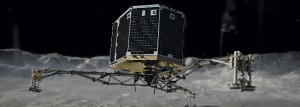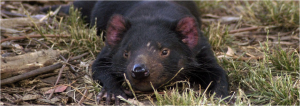Fear gripped the world as the Ebola virus spread across West Africa in the biggest outbreak of the deadly disease since its discovery in 1976. The World Health Organization reported the outbreak in March and by August it had declared an international public health emergency. Since then, the number of reported cases has climbed above 17,000 and more than 6,000 have died, mainly in West Africa. Around 20 people have been treated for the disease in countries outside Africa, but it has yet to reach Australian shores – two suspected cases turned out to be false alarms.
European scientists landed a probe on a comet
In November, European space scientists landed the fridge-sized Philae probe on a speeding comet. The incredible scientific feat involved a decade-long 500 million km trip through space aboard the Rosetta spacecraft to rendezvous with a lump of space rock travelling at 135,000 km/h. Unfortunately, a bumpy landing meant the team lost contact with Philae soon afterwards, but not before the plucky lander had sent back a raft of scientific data, including evidence of carbon compounds – the basis of all life on Earth – on the comet’s surface.

The rest of the world squared up to climate change
2014 may go down in history as the year the world started to accept the need for serious carbon emission cuts to prevent dangerous climate change. In October the EU agreed to slash CO2 to 40 per cent of 1990 levels by 2030, and in November the US and China – the world’s biggest CO2 emitters – finally agreed to start reducing carbon. The US said it would cut CO2 by 26 to 28 per cent of 2005 levels by 2025, while China said it will ensure its emissions peak in 2030. Meanwhile, Australia attracted criticism from the international community for not taking enough action.
Colossal fossil – the biggest ever dinosaur was unearthed
After a local farm worker stumbled across some intriguing remains in the Argentinian desert, scientists dug up the remarkably well preserved skeletons of seven titanosaur sauropod dinosaurs in May. The gigantic herbivorous beasts, which roamed the forests around 100m years ago, are thought to have weighed around 77 tonnes – as much as 14 African elephants. They stood a towering 20m (seven stories) high, and were 40m long, making them the largest animals ever known to walk the Earth.
The roots of sex were seen to be sideways
In October, Australian fossil studies identified the very first beasts to make the beast with two backs – a type of 385 million-year-old Scottish armoured fish called an antiarch. Far from adopting the missionary position, said the scientists, the world’s first lovers copulated in a bizarre square-dance-like display. But the entire animal kingdom subsequently gave the whole thing up and went back to fertilising eggs externally – presumably after the development of a really terrible headache.
We unliked Facebook’s antisocial experiment
The world’s most popular social network came under fire in July as it emerged it had made unwilling, and unaware, guinea pigs of 700,000 users by allowing researchers to manipulate their news feeds for a week. The affected Facebookers saw either only positive or only negative posts, the intention being to see how emotionally-charged information spreads on social networks. PNAS, the journal which published the research, issued an ‘Editorial Expression of Concern’, distancing itself from Facebook’s failure to alert users to the study – an ethically unacceptable approach in academic research circles.
The WWF said we’ve killed half of all Earth’s animals in less than a lifetime
In September, the World Wide Fund for Nature claimed that humans have wiped out more than half of all Earth’s animals in less than 50 years. The report is based on a measure of extinction, The Living Planet Index, which tracks more than 10,000 animal species from 1970 to 2010. However, some scientists questioned the claims, suggesting the index is inaccurate. And in July, CSIRO published a report warning that things are looking grim for Australia’s native mammals too – 113 species are extinct or threatened, and we have the world’s worst record for mammal extinction. The main culprits, according to the report, are feral cats.

A paralysed man walked again, and the answer was right under his nose
October gave us one of the year’s best feelgood science stories; Polish and UK scientists announced that Darek Fidyka, a Polish man paralysed from the chest down in a knife attack in 2010, was able to walk again following a cell transplant from his nasal cavity into his spinal cord. They injected cells called olfactory ensheathing cells above and below the wound, and bridged the gap in his spinal cord with thin strips of nerve tissue taken from his ankle. The transplanted cells stimulated Fidyka’s spinal cord cells to regenerate and grow across the nerve grafts, allowing him to walk with the aid of a frame.
A Japanese stem cell fraud led to shame, sackings and suicide
It was a saga that started off as a miraculous-sounding medical breakthrough, but soon turned into one of the biggest science scandals in recent history. In January, a researcher at Japan’s Riken Center for Developmental Biology, Haruko Obokata, claimed to have discovered a simple, cheap and effective technique for generating stem cells from ordinary cells – the holy grail of stem cell science. But, as time went on, the work started to look decidedly shaky. Other scientists were unable to replicate the results, and issues with the research papers emerged. Obokata was found guilty of professional misconduct and the journal Nature, which published the fraudulent work, retracted the research in July. In a sad twist, Obokata’s supervisor, Yoshiki Sasai, took his own life in August.
Richard III’s remains revealed his life, lunch and grisly end
Confirmation of the ‘carpark’ king’s identity made our top 10 last year, and he makes a repeat appearance this year having drummed up a wealth of column inches in 2014. In May, 3D scans revealed the king was no limping hunchback, despite suffering from scoliosis. In August, analysis of his teeth and bones revealed that, at least towards the end of his life, he enjoyed up to three litres of alcohol daily, and had a taste for scoffing swans, egrets and herons. In September, we learned of Richard’s grisly end – at least 11 injuries, including nine to the head, suggested he probably died a violent death on the battlefield. Then, in December, DNA samples revealed that Richard’s living relatives may be the product of ancient adultery – calling centuries of the British royal bloodline into question.
Credit: Australian Science Media Centre